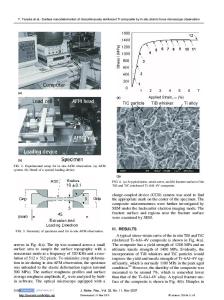In situ bulge testing in an atomic force microscope: Microdeformation experiments of thin film membranes
- PDF / 733,125 Bytes
- 10 Pages / 585 x 783 pts Page_size
- 64 Downloads / 361 Views
new bulge testing setup for the measurement of the mechanical properties of thin films is presented. This self-built device can be incorporated in an atomic force microscope (AFM), which allows the recording of topographic images of the observed sample membranes under load conditions. Bulge test experiments on different silicon nitride films are presented and compared to nanoindentation experiments. The measured elastic moduli from nanoindentation and bulge testing are in good agreement. Apart from that, the ability to extract stress–strain data from AFM scans is shown, and the results are compared to standard bulge testing experiments. Imaging of the sample microstructure under load conditions is demonstrated on a thin Cu film.
I. INTRODUCTION
Due to the increasing application of microelectromechanical devices (MEMS) in recent years, the mechanical properties of thin films have become an important research topic. Basically there are two major reasons why the thin-film mechanical behavior is of interest: the technical reason, i.e., the material properties (e.g., Young’s modulus and residual stress of thin films are very much dependent on the manufacturing conditions; and the scientific reason, i.e., with decreasing film thickness, the mechanical properties deviate from that of bulk materials because the sample dimensions are in an order of magnitude where physical effects, such as dislocation motion, occur.1 Beams and co-workers2 introduced bulge testing of thin freestanding sample membranes in the 1950s as a way to quantify their stress–strain behavior without suffering from substrate influences. The principle of bulge testing is to record the load–deflection (p–h) data of a freestanding membrane, which is uniformly pressurized from one side. Assuming that the bending stiffness is negligible (which is the case as long as the membrane thickness t is four orders of magnitude smaller than the membrane width 2a), load deflection follows the equation: C2Et C10t h + 4 h3 , (1) p= 2 a a where 0 and E denote residual stress and Young’s modulus, respectively. C1 and C2 are constants that dea)
Address all correspondence to this author. e-mail: [email protected] DOI: 10.1557/JMR.2007.0373 2902 J. Mater. Res., Vol. 22, No. 10, Oct 2007 http://journals.cambridge.org Downloaded: 17 Mar 2015
pend on the aspect ratio of the membrane. C2 is also slightly dependent on Poisson’s ratio .3 The stress state in the membrane can be trimmed by variation of the membrane shape. Early experiments were done on circular membranes, but as soon as silicon micromachining processes were available, square and rectangular membranes became common. The stress state in the center of such a square film is biaxial, with C1 ⳱ 3.393 and C2 ⳱ 1/[(1 − )(0.8 + 0.062)].4 For rectangular membranes having an aspect ratio of b/a 艌 4, the constants become independent of membrane shape: C1 ⳱ 2; C2 ⳱ 4/3(1 − 2).5 A detailed derivation of Eq. (1) can be found elsewhere.6 In this special case of rectangular membranes, the strain in the y dire
Data Loading...











